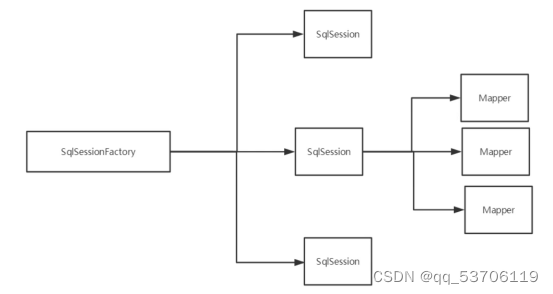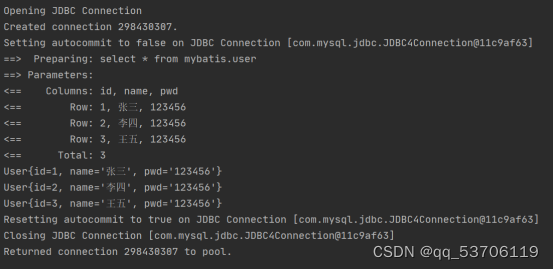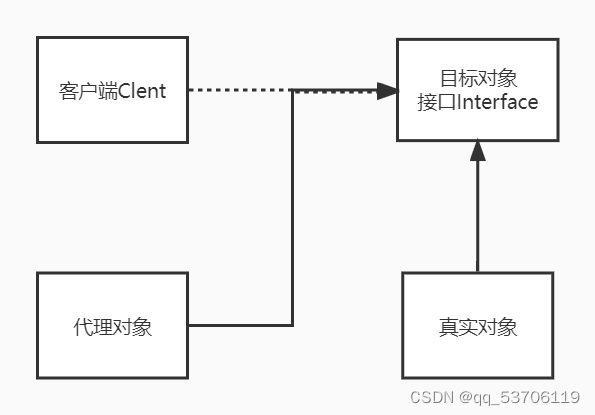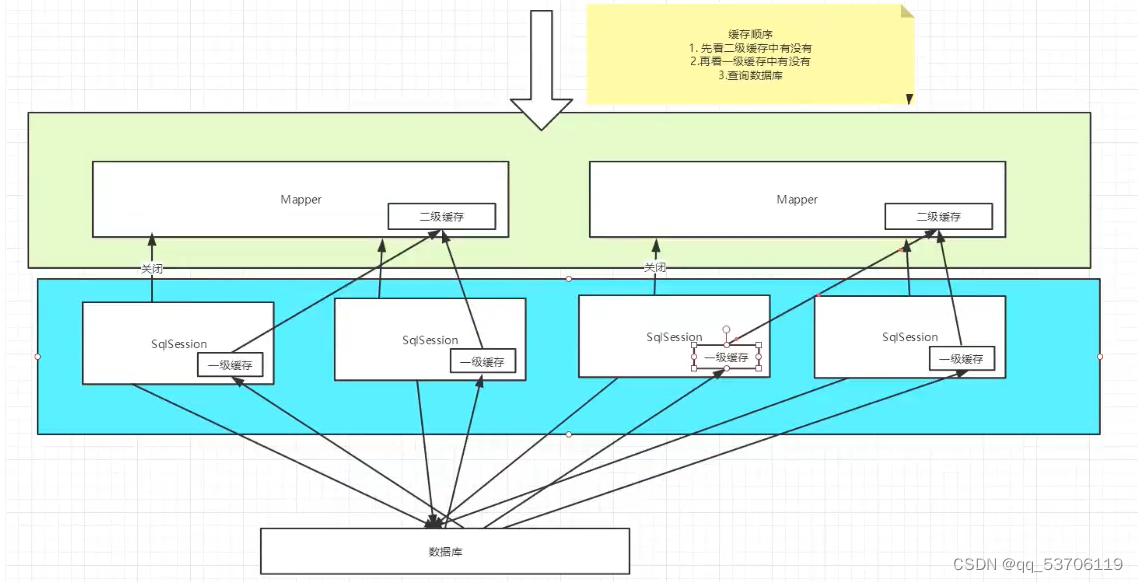1.1、什么是Mybatis
MyBatis 是一款优秀的持久层框架
它支持定制化SQL、存储过程以及高级映射。
MyBatis 避免了几乎所有的JDBC代码和手动设置参数以及获取结果集。
MyBatis 可以使用简单的XML或注解来配置和映射原生类型、接口和Java的POJO (Plain Old Java Objects,普通老式Java对象)为数据库中的记录。
MyBatis 本是apache的一个开源项目iBatis, 2010年这个项目由apache software foundation迁移到了google code,并且改名为MyBatis。
2013年11 月迁移到Github。
如何获得Mybatis?
maven仓库:
<!-- https: //mvnreposi tory. com/artifact/org. mybatis/mybatis -->
<dependency>
<groupId>org. mybatis</groupId>
<artifactId>mybatis</artifactId>
<version>3.5.2</version>
</ dependency>
Github : https://github.com/mybatis/mybatis-3/releases
中文文档: https://mybatis.org/mybatis-3/zh/index.html
持久化
数据持久化
持久化就是将程序的数据在持久状态和瞬时状态转化的过程
内存:断电即失
数据库(JDBC),IO文件持久化
持久化意义:保留有些对象,避免丢失;节省内存
持久层
Dao层,Service层,Controller层...
完成持久化工作的代码块
层界限十分明显
Mybatis意义
帮助程序员将数据存入到数据库中
简化传统的JDBC代码,将复杂重复的代码框架化、自动化。
优点:
sql语句与代码分离,提高了可维护性
提供映射标签,支持对象与数据库的ORM字段关系映射
提供对象关系映射标签,支持对象关系组件维护
提供XML标签,支持编写动态sql
第一个Mybatis程序
思路:搭建环境-->导入Mybatis--->编写代码--->测试
搭建数据库
CREATE DATABASE `mybatis` ;
USE `mybatisi `;
CREATE TABLE `user` (
`id` INT(20) NOT NULL PRIMARY KEY,
`name` VARCHAR (30) DEFAULT NULL,
`pwd` VARCHAR (30) DEFAULT NULL
) ENGINE=INNODB DEFAULT CHARSET=utf8 ;
INSERT INTO `user` ( `id` ,` name`,`pwd` ) VALUES
(1, '张三','123456'),
(2, '李四','123456') ,
(3, '王五',' 123890')
新建项目
- 新建一个普通的maven项目
- 删除src目录
- 导入maven依赖
<!--导入依赖-->
<dependencies>
<!--mysql驱动-->
<dependency>
<groupId>mysql</groupId>>
<artifactId>mysql-connector-java</artifactId>>
<version>5.1.49</version>>
</dependency>
<!--mybatis-->
<!--http://mvnrepository.com/artifact/org.batis/mybatis-->
<dependency>
<groupId>org.mybatis</groupId>
<artifactId>mybatis-typehandlers-jsr310</artifactId>
<version>1.0.2</version>
</dependency>
<!--junit-->
<dependency>
<groupId>junit</groupId>
<artifactId>junit</artifactId>
<version>4.12</version>
<scope>test</scope>
</dependency>
</dependencies>创建一个模块
编写mybatis的核心配置文件
<?xml version="1.0" encoding="UTF-8" ?>
<!DOCTYPE configuration
PUBLIC "-//mybatis.org//DTD Config 3.0//EN"
"http://mybatis.org/dtd/mybatis-3-config.dtd">
<configuration>
<environments default="development">
<environment id="development">
<transactionManager type="JDBC"/>
<dataSource type="POOLED">
<property name="driver" value="com.mysql.jdbc.Driver"/>
<property name="url" value="jdbc:mysql://localhost:3306/?serverTimezone=GMT%2B8&useSSL=true&useUnicode=true&characterEncoding=UTF-8"/>
<property name="username" value="root"/>
<property name="password" value="123456"/>
</dataSource>
</environment>
</environments>
<mappers>
<mapper resource="org/mybatis/example/BlogMapper.xml"/>
</mappers>>
</configuration>编写mybatis工具类
package utils;
import org.apache.ibatis.io.Resources;
import org.apache.ibatis.session.SqlSession;
import org.apache.ibatis.session.SqlSessionFactory;
import org.apache.ibatis.session.SqlSessionFactoryBuilder;
import java.io.IOException;
import java.io.InputStream;
//sqlSessionFactory --> sqlSession
public class MybatisUtils {
private static SqlSessionFactory sqlSessionFactory;
static {
try {
//使用Mybatis第一步:获取sqlSessionFactory对象
String resource="mybatis-config.xml";
InputStream inputStream = Resources.getResourceAsStream(resource);
sqlSessionFactory=new SqlSessionFactoryBuilder().build(inputStream);
} catch (IOException e) {
e.printStackTrace();
}
}
//有了SqlSessionFactory,就可以从中获得SqlSession的实例
//SqlSession完全包含了面向数据库执行SQL命令所需的所有方法
public static SqlSession getSqlSession(){
return sqlSessionFactory.openSession();
}
}编写代码
实体类
//实体类
public class User {
private int id;
private String name;
private String pwd;
public User() {
}
public User(int id, String name, String pwd) {
this.id = id;
this.name = name;
this.pwd = pwd;
}
public int getId() {
return id;
}
public void setId(int id) {
this.id = id;
}
public String getName() {
return name;
}
public void setName(String name) {
this.name = name;
}
public String getPwd() {
return pwd;
}
public void setPwd(String pwd) {
this.pwd = pwd;
}
@Override
public String toString() {
return "User{" +
"id=" + id +
", name='" + name + '\'' +
", pwd='" + pwd + '\'' +
'}';
}
}Dao接口
public interface UserDao {
List<User> getUserList();
}接口实现类
接口实现类由原来的UserDaoImpl转变为一个Mapper配置文件
<?xml version="1.0" encoding="UTF-8" ?>
<!DOCTYPE mapper
PUBLIC "-//mybatis.org//DTD Mapper 3.0//EN"
"http://mybatis.org/dtd/mybatis-3-mapper.dtd">
<!--namespace=绑定一个对应的Dao/Mapper接口 -->
<mapper namespace="com.yu.dao.UserDao">
<!--select查询语句-->
<select id="getUserList" resultType="pojo.User">
select * from mybatis.user
</select>
</mapper>测试
核心配置文件中注册mappers
Junit测试
@Test
public void test(){
//第一步:获得SqlSession对象
SqlSession sqlSession= MybatisUtils.getSqlSession();
//执行getMapper
UserDao userDao=sqlSession.getMapper(UserDao.class);
List<User> userList = userDao.getUserList();
for(User user:userList){
System.out.println(user);
}
//关闭SqlSession
sqlSession.close();
}CRUD
Namespace
namespace中的包名要和Dap/Mapper接口中的包名一致
Select 选择,查询语句
Id:对应namespace中的方法名
ResultType:Sql语句执行的返回值
parameterType:参数类型
1. 编写接口
//根据ID查询用户
User getUserById(int id)2.编写对应的mapper中的sql语句
<selece id=”getUserById” parameterType=”int” resultType=”com.pojo.User”>
Select * from mybatis.user where id = #{id}
</select>3.测试
@Test
public void getUserById(){
//第一步:获得SqlSession对象
SqlSession sqlSession= MybatisUtils.getSqlSession();
//方法一:执行getMapper
UserMapper mapper=sqlSession.getMapper(UserMapper.class);
User user = mapper.getUserById(1);
System.out.println(user);
//关闭SqlSession
sqlSession.close();Insert
<insert id=”addUser” parameterType=”com.pojo.User”>
Insert into mybatis.user (id, name, pwd) value (#{id}, #{name}, #{pwd});
</insert> Update
<update id=”updateUser” parameterType=”com.pojo.User”>
update mybatis.user set name=#{name}, pwd=#{pwd} where id = #{id} ;
</update> Delete
<delete id=”deleteUser” parameterType=”int”>
delete from mybatis.user where id=#{id};
</delete> 注意点:增删改需要提交事务
//提交事务
sqlSession.commit();Map
//定义map类型接口
int addUser2(Map<String,Object> map);<insert id="addUser" parameterType="map">
insert into mybatis.user (id,pwd) value (#{userid},#{passWord});
</insert>@Test
public void addUser2(){
SqlSession sqlSession= MybatisUtils.getSqlSession();
UserDao mapper = sqlSession.getMapper(UserDao.class);
Map<String,Object> map = new HashMap<String, Object>();
map.put("userid",5);
map.put("passWord",222333);
mapper.addUser2(map);
sqlSession.close();Map传递参数,直接在sql中取出key即可 parameterType=”map”
对象传递参数,直接在sql中取出对象的属性即可 parameterType=”Object”
只有一个基本类型参数的情况下,可以直接在sql中取到
多个参数用Map,或者注解
模糊查询
1.java代码执行的时候,传递通配符% %
List<User> userList=mapper.getUserList("%李%");2.在sql拼接中使用通配符
Select * from mybatis.user where name like "%"#{value}"%"配置解析
核心配置文件
mybatis-config.xml
MyBatis的配置文件包含了会深深影响MyBatis行为的设置和属性
configuration(配置)
properties(属性)
settings(设置)
typeAliases(类型别名)
typeHandlers(类型处理器)
objectFactory (对象工厂)
plugins(插件)
environments(环境配置)
environment(环境变量)
transactionManager(事务管理器)
datasource(数据源)
databaseIdProvider(数据库厂商标识)
mappers(映射器)
环境配置
MyBatis可以配置成适应多种环境,但每个SqlSessionFactory实例只能选择一种环境
MyBatis默认的事务管理器就是JDBC,默认连接池: POOLED
属性
可以通过properties属性来实现引用配置文件,这些属性都是可外部配置且可动态替换的,既可以在典型的Java属性文件中配置,亦可通过properties元素的子元素来传递。[db.properties]
编写一一个配置文件
db.propertiesdriver=com. mysq1. jdbc . Driver
ur1=j dbc :mysq1://1ocaThost:3306/mybatisuseSSL=true&useUnicode=true&characterEncoding=UTF-8
username= root
password=123456在核心配置文件中引入
<!--引入外部配置文件-->
<properties resource=”db.properties”>
<property name=”user.name” value=”root”/>
<property name=”pwd” value=”111111”/>
</properties>注意点:
可以直接引入外部文件
可以在其中增加一些属性配置
如果两个文件有同一个字段,优先使用外部配置文件的!
类型别名
类型别名是为Java类型设置一个短的名字
存在的意义仅在于用来减少类完全限定名的冗余
<!--可以给实体类起别名-->
<typeAliases>
<typeAlias type=”com.pojo.User” alias=”User”/>
</typeAliases>也可以指定一个包名,MaBatis会在包名下搜索需要的JavaBean,比如:扫描实体类的包,它的默认别名就为这个类的类名,首字母小写
<typeAliases>
<package name=”com.pojo” />
</typeAliases>在实体类比较少的时候,使用第一种方式,如果实体类十分多,建议使用第二种。
第一张可以自定义别名,第二种则不行,如果非要改,需要在实体类上增加注解
@Alias(“user”)
Public class User {}映射器
MapperRegistry:注册绑定Mapper文件
方式一:
<mappers>
<mapper resource=”com.dao.UserMapper.xml” />
</mappers>方式二:使用class文件绑定注册
<mappers>
<mapper class=”com.dao.UserMapper.xml” />
</mappers>方式三:使用扫描包进行注入绑定
<mappers>
<package name=”com.dao” />
</mappers>注意点:接口与它的Mapper配置文件必须同名且必须在同一个包下!
生命周期和作用域

生命周期和作用域,是至关重要的,错误的食用会导致非常严重的并发问题。
SqlSessionFactoryBuilder:局部变量,一旦创建了SqlSessionFactory,就不再需要它了
SqlSessionFactory:可以想象为数据库连接池
SqlSessionFactory一旦别创建就应该在应用的运行期间一直存在,没有任何理由丢弃它或者重新创建另一个实例。因此SqlSessionFactory的最佳作用域的应用作用域。
最简单的就是使用单例模型或者静态单例模型
SqlSession:连接到连接池的一个请求
SqlSession的实例不是线程安全的,因此是不能被共享的,所以它的最佳作用域是请求或方法作用域。 使用完后需要赶紧关闭,否则资源被占用。

这里面的每一个Mapper就代表一个具体的业务
解决属性名和字段名不一致的问题
测试实体类字段不一致的情况
Public class User{
Private int id;
Private String name;
Private String password;
}出现问题
User{id=1,name=’张三’,password=’null’}
//select * from mybatis.usedr where id = #{id}
//等于
//select id,name,pwd from mybatis.usedr where id = #{id}
解决方法:
- 起别名
<select id=”getUserById” resultType=”com.pojo.User”>
select id,name,pwd from mybatis.usedr where id = #{id}
</select>2.resultMap 结果集映射
Id name pwd
Id name password<!--结果集映射-->
<resultMap id="userMap" type="user">
<! --column数据库中的字段,property实体类中的属性-->
<resu1t column="id" property="id"/>
<result co1umn="name" property="name" />
<resu1t co1umn="pwd" property="password"/>
</resu1tMap><select id="getUserById" resu1tMap="UserMap">
select * from mybatis.user where id = #{id}
</select> IResultMap的设计思想是,对于简单的语句根本不需要配置显式的结果映射,而对于复杂一点的语句只需要描述它们的关系就行了
日志工厂
如果一个数据库操作,出现了异常,需要排错。日志就是最好的助手
logImpl 指定MyBatis所用日志的具体实现,未指定时将自动查找
在Mybatis中具体使用那一个日志实现,在设置中设定
STDOUT_LOGGING标准日志输出
在mybatis核心配置文件中,配置日志
<settings>
<setting name="logImpl" value="STDOUT_LOGGING"/>
</settings> 
Log4j
●Log4j是Apache的一个开源项目,通过使用Log4j,我们可以控制日志信息输送的目的地是控制台、文件、GU|组件
●我们也可以控制每一条日志的输出格式;
●通过定义每一条日志信息的级别,我们能够更加细致地控制日志的生成过程。
●通过一个配置文件来灵活地进行配置,而不需要修改应用的代码。
1.先导入log4j的包
<dependency>
<groupId>log4j</groupId>
<artifactId>log4j</artifactId>
<version>1.2.17</version>
</dependency>2.log4j.properties
#将等级为DEBUG的日志信息输出到console和fi1e这两个目的地,console和file的定义在下面的代码
1og4j. rootLogger=DEBUG,console,file
#控制台输出的相关设置
1og4j. appender .console = org. apache.1og4j . ConsoleAppender
1og4j. appender . console. Target = System. out
1og4j. appender . console. Thresho1d=DEBUG
1og4j . appender . console.1ayout = org. apache.1og4j. PatternLayout
1og4j. appender . console. layout. conversi onPattern= [%c] -%m%n
#文件输出的相关设置
1og4j . appender.file = org. apache.1og4j. Ro1lingFileAppender
1og4j. appender . file. File=. /1og/kuang.1og
1og4j . appender . file. MaxFilesize=10mb
1og4j. appender . file. Thresho1d=DEBUG
1og4j . appender . file.7ayout=org. apache.1og4j. PatternLayout
1og4j . appender . file. layout. conversionPattern=[%p] [%d{yy-MM-dd}] [%c]%m%n
#日志输出级别
1og4j. logger. org. mybatis=DEBUG
1og4j. logger . java. sq1=DEBUG
1og4j. logger .java. sq1. Statement=DEBUG
1og4j. logger . java. sq1. ResultSet=DEBUG
1og4j. logger . java. sq1. Preparedstatement=DEBUG3.配置log4j为日志的实现
<settings>
<setting name="logImpl" value="LOG4J"/>
</settings>log4j的使用
1.在要使用log4j的类中,导入包import org.apache.log4j.Logger;
2.日志对象,参数为当前类的class
Statuc Logger logger = Logger.getLogger(UserDaoTest.class);
3.日志级别
Logger.info(“info:进入了testLog4j”);
Logger.debug(“debug:进入了testLog4j”);
Logger.error(“error:进入了testLog4j”);分页
分页的作用:减少数据的处理量
使用Limit分页
语法:SELECT * from user limit stsrtIndex,pageSize;
SELECT * from user limit 3; #[0,n]使用Mybatis实现分页,核心SQL
1.接口
//分页
List<User> getUserByLimit(Map<String,Integer> map);2.Mapper.xml
<select id=”getUserByLimit” parameterType=”map” resultMap=”UserMap”>
Select * from mybatis,user limit #{startIndex},#{pageSize}
</select>3.测试
@Test
pub1ic void getuserByLimit(){
sqlSession sq1Session = MybatisUtils. getsq1session();
UserMapper mapper = sq1Session. getMapper (UserMapper.c1ass);
HashMap<String, Integer> map = new HashMap<String, Integer>();
map.put("startIndex" ,1);
map.put("pagesize",2);
List<User> userlist = mapper . getuserByLimit(map);
for (User user : userList) {
System. out. print1n(user);
}
sq1Session.close();
}RowBounds分页
不再使用SQL实现分页
1.接口
//分页
List<User> getUserByRowBounds();2.Mapper.xml
<select id=”getUserByRowBounds” resultMap=”UserMap”>
Select * from mybatis,user
</select>3.测试
@Test
pub1ic void getUserByRowBounds(){
sqlSession sq1Session = MybatisUtils. getsq1session();
//RowBounds实现
RowBounds rowBounds = new RowBounds(1,2);
//通过Java代码层面实现分层
List<User> userlist = sq1Session.selectList(“com.dao.UserMapper.getUserByRowBounds”,null,rowBounds);
for (User user : userList) {
System. out. print1n(user);
}
sq1Session.close();
}面向接口编程
在真正的开发中,很多时候都会选择面向接口编程。
根本原因∶解耦,可拓展,提高复用,分层开发中,上层不用管具体的实现,大家都遵守共同的标准.,使得开发变得容易,规范性更好
在一个面向对象的系统中,系统的各种功能是由许许多多的不同对象协作完成的。在这种情况下,各个对象内部是如何实现自己的,对系统设计人员来讲就不那么重要了
而各个对象之间的协作关系则成为系统设计的关键。小到不同类之间的通信,大到各模块之间的交互,在系统设计之初都是要着重考虑的,这也是系统设计的主要工作内容。面向接口编程就是指按照这种思想来编程。
关于接口的理解
接口从更深层次的理解,应是定义(规范,约束)与实现(名实分离的原则)的分离。
接口的本身反映了系统设计人员对系统的抽象理解。
接口应有两类:
第一类是对一个个体的抽象,它可对应为一个抽象体(abstract class);
第二类是对一个个体某一方面的抽象,即形成一个抽象面( interface) ;
一个体有可能有多个抽象面。抽象体与抽象面是有区别的。
三个面向区别
面向对象是指,考虑问题时,以对象为单位,考虑它的属性及方法
面向过程是指,考虑问题是,以一个具体的流程(事务过程)为单位,考虑它的实现
接口设计与非接口设计时针对复用技术而言的,与面向对象(过程)不是一个问题,更多的体现就是对系统整体的架构
使用注解开发
1.注解在接口上实现
@Select(“select * from user”)
List<User> getUsers();2.需要在核心配置文件中绑定接口
<!--绑定接口-->
<mappers>
<mapper class=”com.dao.UserMapper” />
</mappers>本质:反射机制实现
底层:动态代理

Mybatis详细的执行过程

CEUD
可以在工具类创建的时候实现自动提交事务
Public ststic SqlSession getSqlSession(){
Return sqlSessionFactory.openSession(true);
}编写接口,增加注解
public interface UserMapper {
@Select("select * from user")
List<User> getUsers();
//方法存在多个参数,所有的参数前面必须加上: @Param("id")注解
@Select("select * from user where id = #{id}")
User getUserByID(@Param("id") int id);
@Insert("insert into user(id, name, pwd) values (#{id} , #{name} ,#{password})")
int addUser (User user);
@Update("update user set name=#{ name},pwd=#{password} where id = #{id}")
int updateUser (User user);
@Delete("delete from user where id = #{uid}")
int deleteUser (@Param("uid") int id);
}注意:必须将接口注册绑定到核心配置文件中
关于@ Param()注解
基本类型的参数或者String类型,需要加上,引用类型不需要加。
如果只有一个基本类型的话可以忽略,但是建议都加上。
在SQL中引用的就是@Param()中设定的属性名
#{}与${}区别
使用#{}时:
1、用来传入参数,sql在解析的时候会加上" ",当成字符串来解析,如role_ id = "roleid";
2、#{}能够很大程度上防止sq|注入;
使用${}时:
1、用${}传入数据直接显示在生成的sq中,如上面的语句,用role_ id = ${roleldjdbcType=INTEGER}那么sq在解析的时候值为role_ id
= roleid,执行时会报错;
2、${}方式无法防止sq|注入 ;
3、${}一般用于传入数据库对象,比如数据库表名;
4、能用#{}时尽量用#{};
注意: Mybaties排序时使用order by动态参数时,需要使用${}而不用#{}。
Lombok
使用步骤:
1.在IDEA中安装Lombok插件
2.在项目中导入lombok的jar包
<dependency>
<groupId>org.projectlombok</groupId>
<artifactId>lombok</artifactId>
<version>1.18.10</version>
</dependency>3.在实体类上加注解即可
说明:
@NonNull: 用在方法参数前,会自动对该参数进行非空校验,为空抛出NPE (NullPointerException)
@Cleanup:自动管理资源,用在局部变量之前,在当前变量范围内即将执行完毕退出前会清理资源,生成ry-finally的代码关闭流
@Getter/@Setter:用在属性上,不用自己手写setter和getter方法, 还可指定访问范围
@ToString:用在类上,可以自动覆写toString方法
@EqualsAndHashCode:用在类上,自动生成equals方法和hashCode方法
@NoArgsConstructor, @RequiredArgsConstructor and @AllArgsConstructor:用在类上,自动生成无参构造和使用所有参数的有参构造函数。
@Data:用在类上,相当于同时使用了@ToString、@EqualsAndHashCode. @Getter. @Setter和@RequiredArgsConstrutor这些注解, 对POJ0类十分有用
@Value:用在类上,是@Data的不可变形式,相当于为属性添加finalI声明,只提供getter方法, 而不提供setter方法
@SneakyThrows:自动抛受检异常,而无需显式在方法上使用throws语句
@Synchronized:用在方法上,将方法声明为同步的,并自动加锁
Mysql多对一查询方式:
按照查询嵌套处理
<!--思路: .
1.查询所有的学生信息
2.根据查询出来的学生的tid,寻找对应的老师! 子查询
-->
<select id="getStudent" resultMap="StudentTeacher">
<resultMap id="StudentTeacher" type="Student">
<result property="id" column="id"/>
<result property="name" column= "name"/>
<!--复杂的属性,我们需要单独处理对象: association 集合: collection -->
<association property="teacher" column="tid" javaType="Teacher" select=" getTeacher"/>
</resultMap>
<select id="getTeacher" resultType="Teacher">
select * from teacher where id = #{tid}
</select>按照结果嵌套处理
<!--按照结果嵌套处理-->
<select id="getStudent2" resultMap="StudentTeacher2">
select s.id sid,s. name
sname, t. name tname
from student s, teacher t
where s.tid = t.id;
</select>
<resultMap id="StudentTeacher2" type="Student">
<result property="id" column="sid"/>
<result property= "name'”column= "sname"/>
<association property= "teacher" javaType= "Teacher">
<result property= "name" column="tname"/ >
</association>
</resultMap>Mysql一对多查询方式:
按照查询嵌套处理
<select id="getTeacher2" resultMap= "TeacherStudent2">
select * from mybatis. teacher where id = #{tid}
</select>
<resu1tMap id="TeacherStudent2" type= "Teacher">
<col1ection property="students" javaType=" ArrayList" ofType="Student"
select="getStudentByTeacherId" column="id"/>
</resultMap>
<se1ect id=" getStudentByTeacherId" resultType="Student" >|
select * from mybatis. student where tid = #{tid}
</select>
按照结果嵌套处理
<!--按结果嵌套查询-->
<select id="getTeacher" resultMap="TeacherStudent" >
select s.id
sid, s.name sname, t.name tname,t.id tid
from student S, teacher t
where s.tid = t.id and t.id = #{tid}
</select>
<resultMap id="TeacherStudent" type="Teacher">
<result property= "id" column="tid"/>
<result property="name" column="tname"/>
<!--复杂的属性,我们需要单独处理对象: association 集合: collection
javaType="" 指定属性的类型! 集合中的泛型信息,我们使用ofType获取-->
<collection property="students" ofType= "Student" >
<result property="id" column="sid"/>
<result property="name" column="sname"/ >
<result property="tid" column="tid"/>
</collection> l
</resultMap>实体类
@Data
public class Student {
private int id;
private String name;
private int tid;
}@Data
public class Teacher {
private int id;
private String name;
//一个老师拥有多个学生
private List<Student> students;
}小结
关联——association【多对一】
集合——collection【一对多】
javaType & ofType
javaType 用来指定实体类中属性的类型
ofType 用来指定映射到List或者集合中的pojo类型,泛型中的约束
注意点:
保证SQL的可读性,尽量保持通俗易懂
注意一对多和多对一中,属性名和字段的问题
如果问题不好排除错误,可以使用日志,建议使用Log4j
面试高频
Mysql引擎
InnoDB底层原理
索引以及索引优化
动态SQL
动态SQL就是指根据不同的条件生成不同的SQL语句
利用动态SQL的这一特性可以彻底摆脱这种痛苦
搭建环境
CREATE TABLE `blog`(
`id` VARCHAR(50) NOT NULL COMMENT '博客id',
`title` VARCHAR(100) NOT NULL COMMENT '博客标题',
`author` VARCHAR(30) NOT NULL COMMENT '博客作者',
`create_time` TIMESTAMP NOT NULL COMMENT '创建时间',
`views` INT(30) NOT NULL COMMENT '浏览量'
)ENGINE=INNODB ;创建基础工程
- 导包
- 编写配置文件
- 编写实体类
@Data
public class Blog {
private int id;
private String title;
private String author;
private Date createTime;
private int views;
}4.编写实体类对应Mapper接口和Mapper.XML文件
IF
<select id="queryBlogIF" parameterType="map" resultType="com.pojo.Blog">
select * from mybatis.blog where 1=1
<if test="title != null">
and title=#{title}
</if>
<if test="author != null">
and author=#{author}
</if>
</select>Choose(when,otherwise)
<select id="queryBlogChoose" parameterType="map" resultType="com.pojo.Blog">
select * from mybatis.blog
<where>
<choose>
<when test="title != null">
title=#{title}
</when>
<when test="author != null">
and author=#{author}
</when>
<otherwise>
and views=#{views}
</otherwise>
</choose>
</where>
</select>where元素只会在至少有一个条件返回sql字句的情况下插入“where”字句。且若语句的开头为“AND”或者“OR”,where元素也会将它们去除。
<select id="queryBlogIF" parameterType="map" resultType="com.pojo.Blog">
select * from mybatis.blog
<where>
<if test="title != null">
title=#{title}
</if>
<if test="author != null">
and author=#{author}
</if>
</where>
</select>Set标签
<update id="updateBlog" parameterType="map" >
update mybatis.blog
<set>
<if test="title != null">
title=#{title}
</if>
<if test="author != null">
and author=#{author}
</if>
</set>
where id=#{id}
</update>SQL片段
有的时候,会将一些功能的部分抽取处理,方便复用
1.使用SQL标签抽取公共部分
<sql id="if-title-author">
<if test="title != null">
title=#{title}
</if>
<if test="author != null">
and author=#{author}
</if>
</sql>2。在需要使用的地方使用Include标签引用即可
<select id="queryBlogIF" parameterType="map" resultType="com.pojo.Blog">
select * from mybatis.blog
<where>
<include refid="if-title-author"></include>
</where>
</select>注意事项:最好基于单表来定义SQL片段;不要存在where标签
Foreach标签
对一个集合进行遍历,通常是在构建IN条件语句的时候
<select id="queryBlogForeach" parameterType="map" resultType="com.pojo.Blog">
select * from mybatis.blog
<where>
<foreach collection="ids" item="id" open="and (" close=")" separator="or">
id=#{id}
</foreach>
</where>
</select>缓存
缓存的概念:存在内存中的临时数据
将用户经常查询的数据放在缓存中,用户去查询数据就不用从磁盘上(关系型数据库数据文件)查询,从缓存中查询,从而提高查询效率,解决了高并发系统的性能问题。
使用缓存能减少与数据库的交互次数,减少系统开销,提高系统效率。
缓存通常用于存储经常查询并且不经常改变的数据。
Mybatis缓存
Mybatis包含一个非常强大的查询缓存特性,它可以非常方便地定制和配置缓存,缓存可以极大的提升查询效率。
Mybatis系统中默认定义了两级缓存:一级缓存和二级缓存
默认情况下,只有一级缓存开启。(SqlSession级别的缓存,也称为本地缓存)
二级缓存需要手动开启和配置,它是基于namespace级别的缓存。
为了提高扩展性,Mybatis定义了缓存接口Cache。通过实现Cache接口来定义二级缓存。
一级缓存
一级缓存也叫本地缓存:SqlSession
与数据库同一次会话期间查询到的数据会放在本地缓存中。
以后如果需要获取相同的数据,直接从缓存中拿,没必要再去查询数据库;
测试步骤:
- 开启日志
- 测试在一个Session中查询两次相同记录
- 查看日志输出
缓存失效的情况:
- 查询不同的东西
- 增删改操作,可能会改变原来的数据,所以必定会刷新缓存
- 查询不同的Mapper.xml
- 收到清理缓存
一级缓存是默认开启的,只在一次SqlSession中有效,也就是拿到连接到关闭连接这个区间段!一级缓存相当于一个Map。
二级缓存
二级缓存也叫全局缓存,一级缓存作用域太低了,所以诞生了二级缓存
基于namespace级别的缓存,一个名称空间,对应一个二级缓存;
工作机制:
一个会话查询一条数据,这个数据就会被放在当前会话的一级缓存中;
如果当前会话关闭了,这个会话对应的一级缓存就没了;
但是我们想要的是:会话关闭了,一级缓存中的数据被保存到二级缓存中;
新的会话查询信息,就可以从二级缓存中获取内容;
不同的mapper查出的数据会放在自己对应的缓存(map)中;
步骤:
开启全局缓存
<!--显示的开启全局缓存-->
<setting name="cacheEnab1ed" value="true"/>在要使用二级缓存的Mapper中启动
<!--在当前Mapper.XML中使用二级缓存-->
<cache eviction="FIFO" flushInterval="60000" size="512" readOnly="true"/>测试
需要将实体类序列化,否则就会报错
Caused by: java.io.NotSerializableException: com.pojo.User
小结:只要开启了二级缓存,在同一个Mapper下就有效。
所有的数据都会先放在一级缓存中;只有当会话提交或者关闭的时候,才会提交到二级缓存中。
缓存原理图

自定义缓存-ehcache
Ehcache是一种广泛使用的开源Java分布式缓存。主要面向通用缓存。
先进行导包
<dependency>
<groupId>org.mybatis.caches</groupId>
<artifactId>mybatis-ehcache</artifactId>
<version>1.2.2</version>
</dependency>在mapper中指定我们的ehcache缓存实现
<!--在当前Mapper.XML中使用二级缓存-->
<cache type="org.mybatis.caches.ehcache.EhcacheCache"/>




















 2899
2899











 被折叠的 条评论
为什么被折叠?
被折叠的 条评论
为什么被折叠?








